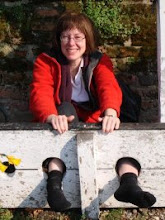
Here is a real Durham strippy - I say "real" because it came from the City of Durham. It was handed in at a charity shop - the Royal Society for the Prevention of Cruelty to Animals - and sold after being washed three times by a volunteer!
This quilt is made of pink and white cotton sateen - it is well used and the sateen has gone as soft as butter - I have never felt a modern cloth that felt like this - it is wonderful to feel. And the oldtime quilters said that it was lovely to quilt, which I can well believe. But it was labour intensive cloth to make (although it was inexpensive to buy) and was last manufactured in Britain in 1939. The war meant that materials and labour were both in short supply.

The patterns follow the strips, and are a twist, a four lobed design, bellows and cross hatch infill (hand marked, as the lines are a bit curved and not straight as they would be if marked with a straight edge)

The edge of the quilt, showing the machine sewing to secure the edge, and also how the strips were run up on the machine. A very typical strippy, in a very typical colour combination.

The patterns follow the strips, and are a twist, a four lobed design, bellows and cross hatch infill (hand marked, as the lines are a bit curved and not straight as they would be if marked with a straight edge)
A photo of the back, which is a plain white sateen. The size is 94 x 72 inches and the wadding is cotton. The edges are machine sewn.

The edge of the quilt, showing the machine sewing to secure the edge, and also how the strips were run up on the machine. A very typical strippy, in a very typical colour combination.
As you know, these quilts were often made by quilters running quilt clubs, where a weekly payment of a shilling went towards the purchase of a quilt, with the names put into the hat to see whose was made first - there were usually about 20 people paying their weekly money. an early form of social help. Often the only income for a family on hard times or where the main earner had met with an accident. Durham of course had a coal field and many mines or collieries, but these were few in number when I was a student in the 70's, and are now all shut down, along with the steel mill.
A life which has disappeared now, and is only visible when talking to older folks or at Beamish Museum.



Oh my gosh! That is such a beautiful quilt! Such soft colors and reading about how it feels I could almost feel it sliding over my fingers. I do enjoy seeing your Welsh quilts. They are so distinctive.
ReplyDeleteI love the soft pink color. I can see why you are making your pink and white quilt, it's very engaging. I, like Taryn, could feel the softness of this quilt while you were discribing it.
ReplyDeleteOne of my goals is to make a Durham-type stippy quilt. I'd like to make mine white and a soft beige. Do you have any great sources for designs used in traditional strippy quilts? I live in the USA--but I love the handquilting!
ReplyDelete